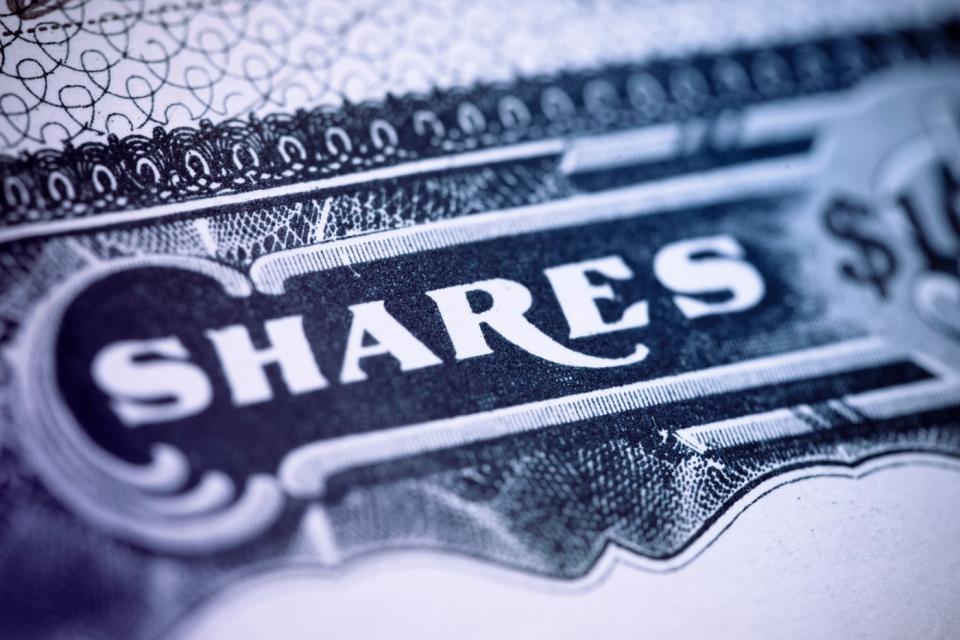Since the start of 2023, the artificial intelligence (AI) revolution has been the key catalyst that’s sent the growth-focused Nasdaq Composite, broad-based S&P 500, and even the ageless Dow Jones Industrial Average, to fresh record-closing highs. But don’t overlook the role stock-split euphoria has played in pushing Wall Street’s leading businesses higher.
A stock split is an event that allows a publicly traded company the opportunity to alter its share price and outstanding share count by the same factor. Stock splits are purely superficial in the sense that a company’s market cap and operating performance are both unaffected by adjusting its share price and outstanding share count.
Although there are two types of splits — forward and reverse — investors clearly favor one more than the other. With a reverse-stock split, a company is purposely increasing its share price. This is usually done to ensure it meets the minimum share price for continued listing on a major stock exchange. Meanwhile, a forward-stock split reduces a company’s share price. The goal here is to make shares more nominally affordable for everyday investors and/or employees who may not be able to make fractional-share purchases with their broker.
With most reverse-stock splits undertaken in positions of weakness, investors tend to flock to businesses conducting forward splits.
Since 2024 began, 12 prominent businesses have announced a stock split — only one of which has been of the reverse-split variety. However, the value proposition for these one dozen stock-split stocks differs quite a bit.
After reviewing Wall Street’s cheapest stock-split stocks last week, let’s a take a closer look at three of the priciest stock-split stocks — all of which are worth avoiding for various reasons (including valuation). Keep in mind that “valuation” is a subjective term, and there’s more than one metric to determine if a stock is pricey, relative to the broader market or its peers.
Nvidia: 38 times trailing-12-month sales
By some traditional valuation metrics, the hardware king of AI, Nvidia (NASDAQ: NVDA), isn’t all that expensive. But based on its trailing-12-month (TTM) price-to-sales (P/S) ratio, which I’ll touch on a bit later, Nvidia’s stock is priced in nosebleed territory.
As you’re probably aware, Nvidia has quickly become the face of the artificial intelligence revolution. Its H100 graphics processing units (GPUs) are the preferred chip in enterprise data centers running generative AI solutions and training large language models. An estimated 98% of the 3.85 million GPUs shipped to data centers in 2023 were Nvidia chips.
With demand for the company’s hardware handily outstripping supply, Nvidia has seen its sales, profits, and adjusted gross margin ascend to the heavens. A market cap gain in excess of $2 trillion since the start of 2023 is what coerced Nvidia’s board to complete a historic 10-for-1 split following the closing bell on June 7.
But it’s not all peaches and cream for this leading AI stock. Nvidia is set to face a slew of competition. In addition to external competitors introducing AI-GPUs to rival the H100, Nvidia’s four largest customers (all members of the “Magnificent Seven”) are developing AI chips of their own. These GPUs are going to take up valuable data center real estate and lessen Nvidia’s otherworldly pricing power and adjusted gross margin.
There also hasn’t been a next-big-thing technology or trend for 30 years that’s escaped an early innings bubble. Put another way, investors constantly overestimate the uptake and/or utility of new innovations or trends. This is almost certainly the fate that awaits artificial intelligence, which isn’t close to being a mature technology, as of now.
The nail in the coffin for Nvidia is that it’s valued at 38 times its TTM sales. This is pretty much the same level we witnessed Amazon and Cisco Systems peak at prior to the dot-com bubble bursting. Market-leading companies aren’t typically this pricey, which is why Nvidia can be easily avoided.

Chipotle Mexican Grill: 39 times forward-year earnings
Another popular stock-split stock that’s anything but a value is fast-casual restaurant chain Chipotle Mexican Grill (NYSE: CMG). Following the close of business on June 25, Chipotle completed its first-ever stock split, 50-for-1.
It’s not an accident that Chipotle’s stock has gained more than 11,800% from its January 2006 initial public offering (IPO) price of $22 ($0.44 on a split-adjusted basis). This is a company that’s used its competitive advantages to consistently outperform other fast-casual restaurant chains.
For example, Chipotle Mexican Grill has benefited from the decision to keep its menu on the small side. A smaller menu allows its workers to prepare food fresh daily, and ensures that meals can be put together quickly for in-store and drive-thru customers. A limited menu also creates more buzz when a new item is introduced.
Innovation has been important, too. Aside from introducing new menu items from time to time, the company’s decision in 2018 to begin leaning on mobile order-dedicated drive-thru lanes, known as “Chipotlanes,” has been a game-changer.
But there’s only so much innovation you can squeeze out of the proverbial orange. While Chipotle is sustaining double-digit sales growth, roughly half of its growth in the March-ended quarter came from opening new stores. On an organic growth basis, Chipotle’s same-restaurant sales increased by a more modest 7% in the first quarter.
On one hand, 7% organic sales growth from a $72 billion company is fantastic. But when that company is valued at 39 times forward-year earnings, 7% organic sales growth — some of which is being fueled solely by inflation and has nothing to do with consumers’ buying additional items or visiting more often — is anything but impressive.
With euphoria from its recent split beginning to fade, it wouldn’t be surprising to see Chipotle Mexican Grill’s stock meaningfully pull back.
MicroStrategy: $32 billion market cap with an unprofitable operating model
However, the priciest of all stock-split stocks looks to be AI-inspired enterprise analytics software provider MicroStrategy (NASDAQ: MSTR).
Although MicroStrategy has had its software division for decades, the company and its outspoken CEO, Michael Saylor, are best known for buying and holding the world’s largest cryptocurrency by market value, Bitcoin (CRYPTO: BTC). Since the end of April, Saylor’s company purchased 11,931 additional Bitcoins, which brought its total to 226,331 Bitcoins, as of June 20. This represents more than 1% of all Bitcoins that will ever be mined.
A more-than-quadrupling in the value of Bitcoin since late 2022 has sent MicroStrategy’s stock soaring. This is what compelled its board to announce a 10-for-1 stock split, which will become effective following the close of business on August 7.
But there are reasons to believe MicroStrategy’s stock is in an even bigger bubble than Nvidia.
For instance, a strong argument can be made that Bitcoin’s first-mover appeal is long gone. It’s nowhere close to being the fastest or cheapest payment network, and a few lines of computer code give the false perception of scarcity.
Even more concerning is the premium investors are placing on MicroStrategy’s Bitcoin assets, relative to the current value of each token. With Bitcoin valued at $66,000, as of this writing, MicroStrategy’s Bitcoins are collectively worth about $14.9 billion. However, its $32 billion market cap implies that investors are valuing its Bitcoin assets at around $30 billion, or closer to $132,000 per token. If you want to invest in Bitcoin, it makes no sense whatsoever to pay $132,000 per coin via MicroStrategy when you can purchase it on an exchange for $66,000.
Furthermore, MicroStrategy has been financing its Bitcoin purchases by selling convertible debt. If Bitcoin endures another steep decline of more than 80%, which has become commonplace every couple of years, MicroStrategy could struggle to meet its debt obligations.
Lastly, MicroStrategy’s software business has gone nowhere, with sales down 14% over the last decade. A money-losing company built on a house of cards usually makes for a terrible investment.
Should you invest $1,000 in Nvidia right now?
Before you buy stock in Nvidia, consider this:
The Motley Fool Stock Advisor analyst team just identified what they believe are the 10 best stocks for investors to buy now… and Nvidia wasn’t one of them. The 10 stocks that made the cut could produce monster returns in the coming years.
Consider when Nvidia made this list on April 15, 2005… if you invested $1,000 at the time of our recommendation, you’d have $692,784!*
Stock Advisor provides investors with an easy-to-follow blueprint for success, including guidance on building a portfolio, regular updates from analysts, and two new stock picks each month. The Stock Advisor service has more than quadrupled the return of S&P 500 since 2002*.
See the 10 stocks »
*Stock Advisor returns as of July 22, 2024
John Mackey, former CEO of Whole Foods Market, an Amazon subsidiary, is a member of The Motley Fool’s board of directors. Sean Williams has positions in Amazon. The Motley Fool has positions in and recommends Amazon, Bitcoin, Chipotle Mexican Grill, Cisco Systems, and Nvidia. The Motley Fool has a disclosure policy.
These Are 3 of the Priciest Stock-Split Stocks on Wall Street — and Yes, They Should Be Avoided was originally published by The Motley Fool
Credit: Source link




